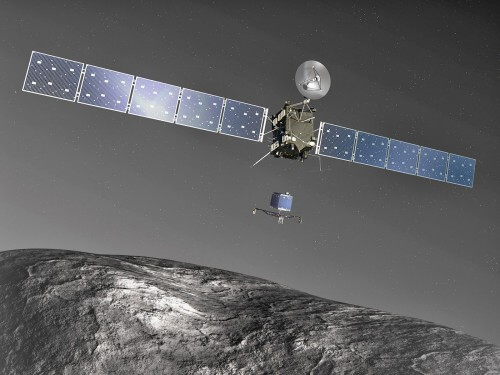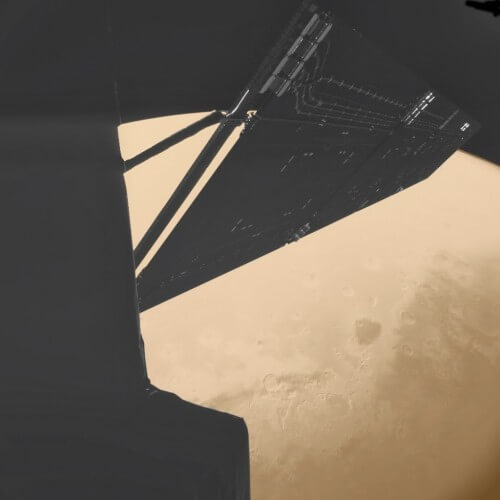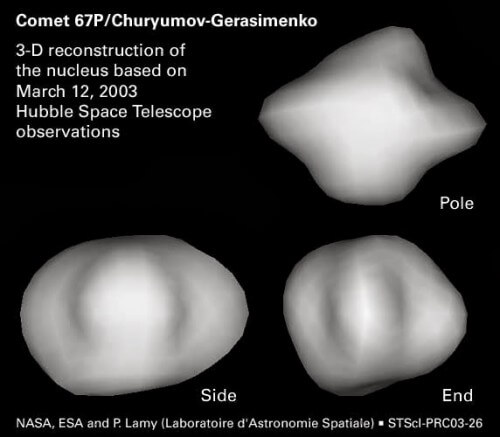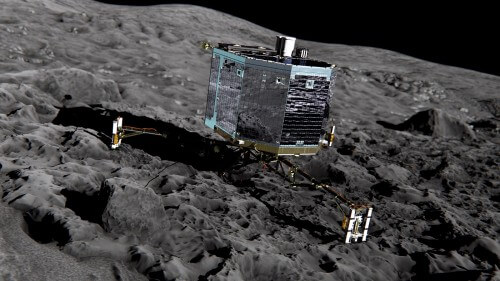Today (Monday, January 20, 2014) the European Space Agency will send wake-up commands. After a decade in space, it is approaching Comet Churyumov-Grasimenko

For contemporary see: Rosetta woke up and called home
In December 2002, the main part of my work focused on the preparations for the launch of the Amos-2 communication satellite, which was supposed to fly into space about six months later, on top of the Ariane-5 launcher of the new ECA model.
In the same month, the first launch of this model took place. during launch An error occurred The cooling system of the engines and the launcher was destroyed along with the two satellites that were packed inside. Since the queue of launches started to be postponed, our launch was also postponed, and the postponement even resulted in a change of the launch company.
At the same time, I started visiting the Department of Geophysics and Planetary Sciences at Tel Aviv University to start my master's degree there, and that's where I first heard about the Rosetta spacecraft, which was supposed to board the Ariane-5 launch in January 2003, and the launch was postponed to March 2004. The postponement of the launch for Rosetta was even more problematic, because She lost the window of opportunity to meet the comet Wirtnan (46P/Wirtanen), for which it was designed, and to replace it with another comet.
After almost a decade in space, the Rosetta mission reaches its peak this year, and it is a mission that is very much worth getting to know.
The Rosetta mission is a mission to chase after a comet, approach and stay with it for an extended period of time, and land a research probe on its surface. So far there have been several spacecraft that have passed close to comets, photographed them up close and even collected material from their tails, but no spacecraft has ever stayed close to a comet for an extended period of time.

Since comets are leftovers from the formation of the solar system, which have remained frozen and unchanged since the sun began its activity, it is possible to derive a great deal of knowledge from their composition and structure. There is evidence that much of Earth's water came from comets, as did some of the gases in the atmosphere and perhaps even the basic organic matter. Understanding these bodies is important for understanding the processes that took place in the solar system billions of years ago, and for understanding the processes that took place on the Earth's surface at the beginning of its existence.
That is why the task is named after the Rosetta Stone, whose discovery led to a breakthrough in the interpretation of ancient Egyptian hieroglyphs at the end of the 18th century.
To reach a comet when it is far from the sun, and its surface is still inactive (which will make it difficult to approach and land), you have to wander away from the sun. Reaching these distances with a large spacecraft is a lengthy task that requires a lot of fuel, or using the planets' gravity to gain the necessary speed. The Rosetta mission was designed to pass by Earth, by Mars, and again by Earth, and only then would it have enough speed to reach its comet.
Mars (and part of Rosetta) as photographed by the Philae lander camera.
After Ariane's launch failure, the European Space Agency had to find a new target for the Rosetta mission. The chosen target was a comet named Churyumov-Grasimenko (67P/Churyomov-Gerasimenko), mainly because it was possible to leave the flight path without major changes. On the other hand, Comet Churyumov-Grasimenko is larger than Comet Virtanen (diameter 4 km compared to 1 km), so its gravity is greater. Therefore, the structure of the lander's landing pad had to be changed. Churyumov-Grasimenko was discovered in 1969. It is smaller and darker than a lump of coal and therefore difficult to identify since then. Our nucleus was first imaged in 2003 by the Hubble Space Telescope.

Rosetta will reach its destination in the summer of 2014, so this year will be the culmination of the mission. In the years that have passed since the launch, she managed to take a close-up photo of two asteroids that she passed by, take a photo of Mars from a distance of 1,000 km, watch the precise impact of the spacecraft Deep-Impact Beshvit Temple-1 and more.
As of the writing of this entry, Rosetta is immersed in a deep sleep designed to save its instruments from the radiation damage of deep space. Over 900 days of winter sleep will come to an end this coming Monday (20/1/2014 at 12:00 noon Israel time). Then the command will be sent to her to wake up, warm up her sensors and start preparing for the encounter with the comet.
Rosetta must approach the comet and begin circling it. First it must adjust its speed to the speed at which the comet moves around the sun. Second, orbiting a body that produces almost no gravity is not a simple matter at all, and Rosetta will be forced to do so in a series of delicate maneuvers around it. The approach process will reach its peak between the months of May and August 2014. Rosetta will map the surface to find a suitable landing site. This is also not a trivial task because the comet is not spherical. In fact, its shape resembles the shape of the "+" sign. It is likely that the ideal landing site would be on one of the comet's vertices, because gravity is lower there.
In the month of November, the Philae lander will detach, named after an island in the Nile River where an obelisk bearing the inscription Khartoum is found, translated into Greek, which, together with the Rosetta Stone, was used in deciphering the ancient Egyptian language.
Philae will land on the comet's surface using a small rocket engine, which will be used to boost the meager gravity. Its three legs will be driven into the ground by means of screws designed to be caught in the ground made of ice. The lander body is insulated from the leg mechanism so as not to heat the frozen ground.
Philae carries a rather impressive arsenal of scientific instruments for a lander weighing only 100 kg. 21 kg of weight are the ten scientific instruments, and this ratio is unprecedented in space exploration missions!

In addition to cameras, it has equipment for chemical, electrostatic and isotopic examination of materials from the surface, from the dust above it, and from the ground below it. It has a microscope and an oven for examining types of minerals and their structure, a system for examining the mechanical and thermal stability of the soil, magnetic field and plasma sensors, and an instrument for examining the structure of the comet by acoustic means and by transmitting and receiving radio waves through the body of the comet between it and Rosetta (Want to know more? Now possible with Lego!).
Rosetta itself has a stockpile of scientific instruments for remote sensing of the comet and its surroundings, and together with the lander unprecedented data collection work will be carried out in planetary research.
Around the time of landing, the comet will begin to approach the Sun slowly, and the surface is expected to become active as the ice warms and melts. Rosetta is planned to remain around it for about a year and continue documenting what is happening on its surface. There are many expectations from this mission, but first she must wake up from her slumber.
The European Space Agency is promoting the event with a video contest calling to wake up Rosetta, in which the public is invited to join. The winner will receive a visit to the control room on the landing date in November.
Pay attention to this task. If all goes well, surprising discoveries and spectacular photographs are expected later this year from this amazing mission.
On January 18th, we talked about the Rosetta mission in the Internet program "The Spacecraft". You are welcome to watch it.

7 תגובות
Yoav Shalom,
In your beautiful article, you did not mention that there are miniature cryogenic refrigerators manufactured by "Rikor" in Ein-Harod Ihud,
I guess it's ignorance about Ricoh. I invite you to review the material on Recour as well as various references to the refrigerators in the spaceship.
I also invite you for a sightseeing visit, to get an impression of the factory, which is the world's leader in its field.
Greetings Zvi
Contact has been made, I will update later